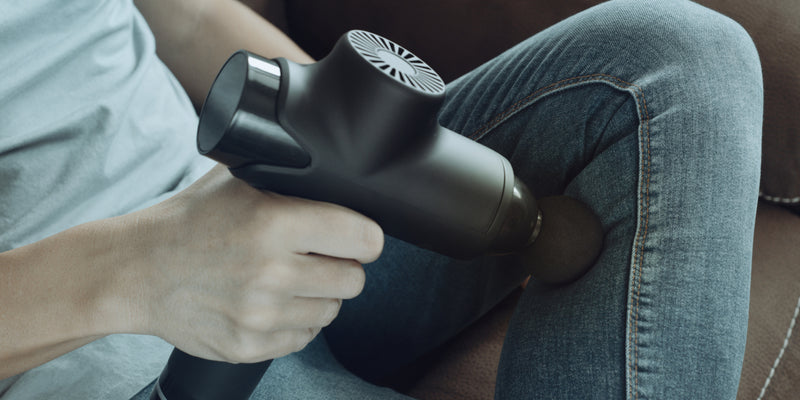Migraine headaches can be debilitating, leaving sufferers searching for relief. While medication and traditional therapies can help, many people are turning to a unique solution - vibration therapy. This innovative approach uses targeted vibrations to provide drug-free migraine management, offering hope to those seeking an alternative to pills and injections.
With that said, let’s explore how vibration therapy can be used to alleviate the painful symptoms of migraine. Whether you're dealing with chronic migraines or occasional flare-ups, the insights in this article could help you find lasting relief and take back control of your health.
So, if you're ready to put the power of vibration to work for your migraine woes, wave goodbye to the ache and say hello to a life with less pain once more!
How Does Migraine Impact Our Daily Life?

Migraine, a neurological condition characterized by intense headaches and a range of other debilitating symptoms, can significantly impact our daily lives. This condition affects millions of people worldwide and is known to disrupt daily routines, limit productivity, and diminish overall quality of life. To gain a deeper understanding of how migraines impact our daily lives, it is crucial to explore the various ways in which this condition can create significant challenges and limitations. From the physical pain and discomfort to the emotional and social repercussions, migraines leave a lasting impact on our personal and professional lives. By gaining insights into these effects, we can develop a better understanding of the necessity for proper management and support, aiming to alleviate the burden caused by this relentless neurological condition.
How Widespread is Migraine?
Migraine is a common neurological disorder affecting a significant portion of the population worldwide. Research shows that back in 2019, migraines are prevalent in about 1.1 billion individuals globally.
The frequency of migraine episodes can vary widely among individuals. While some people experience only a few migraine attacks per year, others might have several episodes per month. On average, individuals with migraines report having around two to four episodes per month, lasting anywhere from hours to days. This can have a profound impact on the quality of life, with migraine sufferers often experiencing moderate to severe pain, nausea, vomiting, sensitivity to light and sound, and fatigue during an attack.
The occurrence of migraines can be influenced by various factors or triggers. These can vary widely between individuals. Some potential triggers include hormonal changes, such as those that occur during menstruation or menopause, emotional stress, lack of sleep, certain foods or drinks, such as alcohol or caffeine, environmental factors like strong odors or bright lights, and changes in weather or barometric pressure. Identifying and managing these triggers is crucial in reducing the frequency and severity of migraine episodes.
5 Common Treatment Options for Migraines

Migraines can be debilitating, but there are several treatment options available that can effectively alleviate symptoms. Here are five common treatment options for migraines:
- Medication: There are several types of medications recommended for migraines, including pain relievers, triptans, and anti-nausea drugs. Pain relievers such as nonsteroidal anti-inflammatory drugs (NSAIDs) can help reduce pain, while triptans work to constrict blood vessels in the brain and reduce inflammation. Anti-nausea drugs can provide relief from migraine-related nausea and vomiting. These medications are effective in relieving migraine symptoms by targeting the underlying causes of the condition.
- Lifestyle changes: Making certain lifestyle modifications can also be effective in managing migraines. These changes may include maintaining a regular sleep pattern, avoiding triggers such as certain foods or bright lights, managing stress levels, and incorporating regular exercise into daily routine. These lifestyle changes help to reduce the frequency and severity of migraines by minimizing triggering factors and promoting overall well-being.
- Alternative therapies: Various alternative therapies have shown promise in providing relief from migraines. Techniques such as acupuncture, massage, and biofeedback have been found to be effective in reducing the frequency and intensity of migraines. These therapies work by promoting relaxation, improving blood flow, and reducing tension, ultimately relieving migraine symptoms.
- Preventive measures: In addition to immediate treatment options, implementing preventive measures is crucial in managing migraines. This can involve identifying and avoiding triggers, taking prescribed preventive medications, and maintaining a healthy lifestyle. Preventive measures focus on minimizing the occurrence and severity of migraines over the long term, providing sustained relief from migraine symptoms.
- Consultation with healthcare professionals: It is of utmost importance to consult a healthcare professional for personalized treatment plans. Migraine treatment varies from person to person, and a healthcare professional can provide expert guidance in choosing the most suitable treatment options. They can evaluate the individual's medical history, symptoms, and lifestyle to develop a comprehensive treatment plan tailored to their specific needs.
Can Vibration Therapy Manage Migraines?

Although the exact cause of migraines is still not fully understood, various treatment options have been explored to alleviate the debilitating effects they can have on individuals' daily lives. One emerging therapy which has gained attention is vibration therapy. By utilizing the benefits of controlled vibrations, this non-invasive approach aims to reduce the severity and frequency of migraines.
First, the vibrations seem to disrupt and block the transmission of pain signals from the trigeminal nerve, which is closely linked to migraine attacks. This can provide rapid, drug-free relief from migraine pain. Vibration therapy also helps relax the muscles in the neck, shoulders, and head, reducing the muscle tightness and spasms that often accompany migraine episodes. Additionally, the vibrations stimulate increased blood circulation, which may help flush out inflammatory substances that contribute to migraine pain.
Studies have found vibration therapy to be particularly helpful for managing the acute phase of a migraine attack, as well as preventing future episodes when used regularly. Many migraine sufferers report significant reductions in both the frequency and severity of their headaches when incorporating vibration therapy into their treatment plan. The portability of many vibration therapy devices also makes it a convenient option that can be used at the first signs of a migraine, providing fast-acting relief.
What Do You Need to Consider Before Undergoing Vibration Therapy for Migraine?
Before undergoing vibration therapy for migraine, there are a few key things to consider. First and foremost, it's important to discuss vibration therapy with your doctor or migraine specialist before trying it. They can help determine if it's a suitable option based on your individual health needs and current migraine treatment plan and may have recommendations on the type of vibration therapy device or protocols to use.
It's also important to understand the potential risks associated with vibration therapy. While it is generally considered safe, there are some potential risks to be aware of, such as skin irritation, muscle soreness, and potential worsening of certain medical conditions like deep vein thrombosis. Individuals with certain neurological conditions, metal implants, or other health concerns may need to avoid vibration therapy.
When first trying vibration therapy, it's best to start slowly, with short sessions of 10-15 minutes, and slowly increase the duration as your body adjusts. Pay attention to how your body responds and adjust the intensity, duration, and frequency as needed, as some trial and error may be required to find the optimal vibration therapy routine for your migraines.
It's also important to consider incorporating vibration therapy into a comprehensive migraine management plan, rather than relying on it alone. Vibration therapy works best when combined with other strategies, such as stress reduction, proper sleep, and dietary changes. Keeping a journal to track how your migraines respond to vibration therapy over time can also help you and your healthcare provider assess the effectiveness and make any necessary adjustments.
Who Should Avoid Vibration Therapy for Migraine?
Vibration therapy for migraines can be a beneficial treatment option for many individuals. However, there are certain contraindications and unsuitable conditions that should be considered before engaging in this therapy. Individuals who have certain medical conditions or circumstances should avoid vibration therapy for migraines.
Contraindications to vibration therapy include acute migraines, as the vibrations may exacerbate the symptoms and increase discomfort. Individuals with any open wounds, cuts, or bruises on the head or neck should also avoid this therapy, as the vibrations could potentially hinder the healing process, cause further injury, or intensify pain.
Additionally, those with a history of neck or spinal cord injuries, such as herniated discs or nerve impingements, should refrain from vibration therapy. The vibrations may put additional strain on already compromised areas, leading to further damage or increased pain.
Furthermore, individuals who have epilepsy or a history of seizures should avoid vibration therapy. The mechanical vibrations could potentially trigger a seizure episode or worsen the condition.
It is important to note that although vibration therapy is generally safe, there are potential risks and complications associated with this treatment. These may include dizziness, headache exacerbation, muscle soreness, or the aggravation of existing medical conditions. It is advisable to consult with a healthcare professional before starting vibration therapy for migraines to ensure its suitability and safety in individual cases.
Takeaway
Vibration therapy offers a unique and promising solution for individuals struggling with the debilitating effects of migraine headaches. By utilizing targeted vibrations, this drug-free approach aims to disrupt the transmission of pain signals, relax muscles, and improve blood circulation - all of which can provide rapid relief during acute migraine episodes. Studies have shown vibration therapy to be effective in reducing both the frequency and severity of migraines when used regularly as part of a comprehensive treatment plan. The portability of many vibration devices also makes it a convenient option that can be used at the first signs of a migraine attack.
However, it's important to consult with a healthcare professional before trying vibration therapy, as there are some contraindications and potential risks to be aware of. Individuals with certain medical conditions, neurological disorders, or injuries may need to avoid this treatment. Proper guidance is crucial to ensure vibration therapy is a safe and effective migraine management strategy. Overall, the insights provided in this article highlight the potential of vibration therapy to empower migraine sufferers and offer a new avenue for drug-free relief. By exploring this innovative approach, individuals dealing with chronic or episodic migraines may be able to reclaim control over their health and quality of life. The future holds promise for vibration therapy as a valuable tool in the migraine management toolkit.
Renpho Health Tips
-

Vibrating Away Stress and Tension: How Therapeutic Vibration Can Transform Your Wellness Routine
May 20, 2024
Read more >
-

Massage Gun Heads 101: Everything You Need to Know
May 13, 2024
Read more >
-

How to Use a Massage Gun for Shoulder Pain Relief
May 2, 2024
Read more >
-

Massage Guns for Knee Pain: 5 Effective Techniques and Best Practices
April 24, 2024
Read more >
-

5 Self-Care Practices for Chronic Pain Treatment and Management
April 24, 2024
Read more >

